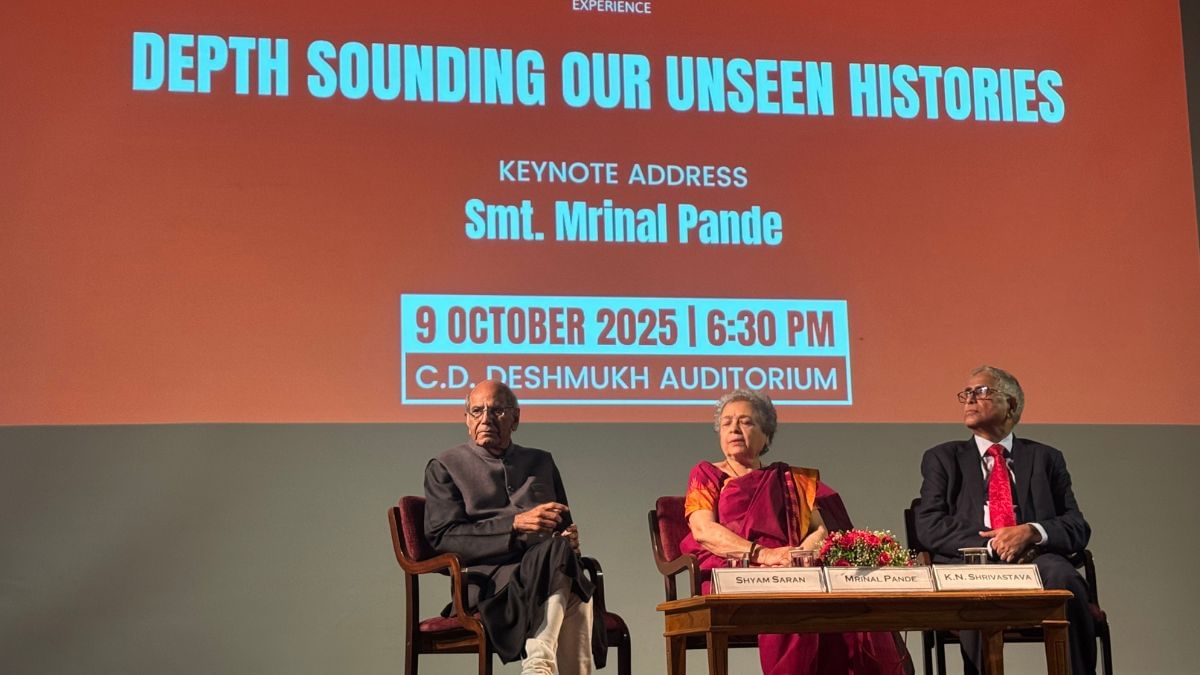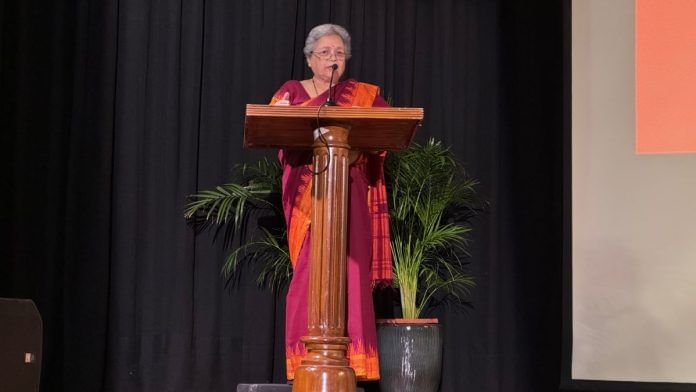Delhi: History is not linear. As one goes deeper, new layers unfold, like during excavation. Similarly, a woman is shaped by what is seen and what remains unseen — the product of layered histories, said journalist and author Mrinal Pande.
“So, my mind goes to my grandmother’s house — the house that embodies my childhood history. It is where we were told about my mother’s illustrious male ancestors. There was no mention of wives or daughters,” said Pande at the India International Centre (IIC) on 9 October evening.
Pande was the keynote speaker and curtain raiser for the Festival of Arts at IIC. IIC President Shyam Saran was in the chair to formally inaugurate the festival. Her address, titled ‘Depth Sounding Our Unseen Histories’, unravelled the history of inequality and the rise of rebellious women across generations.
The C.D. Deshmukh auditorium was filled with veteran journalists, artists, and academicians, gathered to hear her speak. Pande revisited childhood memories of how women were excluded not just from family stories, but also from rituals and important celebrations.
She recalled how, in her family, even the names of women were often unknown — they were referred to by their husbands’ identities.
“So, the first wife was called Sundari Rani. The second was called Mundari Rani. The third was Manjari Rani. And — hold your laugh — the fourth was called Khanjari Rani,” said Pande, prompting laughter from the audience.
She pointed out how such exclusion continues today in rituals like the Yagnopaveet ceremony, where the Gayatri Mantra is whispered by a man into a boy’s ear so that no woman hears it.
“This is how personalities are shaped for most girls in India. And I am not talking about very liberal, very urbanised, sophisticated families. I am talking about average families like ours,” Pande added.

Toughies of ancient granths
Pande traced the journey of women and how they expressed themselves in ancient times. She pointed out that the earliest references come from studies of mantra drashtas—women like Apara and Gosha—but their true identities and original words remain unknown, as their work has been preserved only through compilations by others.
“Later, the Smriti Granth introduces the Brahmavate—the most progressive woman who laid down laws for society and politics,” Pande said.
Among them was Maitreya, a Brahmavatini and wife of the Hindu sage Yajnavalkya. She was outspoken and wise, capable of understanding sacred mantras. And his second wife was Katayani. Pande also mentioned one Gargi, who chose not to marry.
Pande said that the philosophical debates of a Yajnavalkya with Maitreya have been noted down by men. When Yajnavalkya proposed dividing his property equally between his two wives, Maitreya questioned the value of material wealth by asking that if she had half of whatever he possessed, will she also be immortal?
“Yajnavalkya said no and then she said that I don’t need your wealth, give me Brahman – the wealth of immortality,” Pande read out the text.
Pande said that even Gargi questioned Yajnavalkya on the idea of Brahman – the ultimate reality – and why it was seen as one. “She says each tattva in the world is composed of two. Even for weaving you need a woof and a weft. She questions his definition of Brahman which makes Yajnavalkya very angry. She was a toughie,” Pande laughed.
Also read: SEWA is still fighting for women’s ‘dusri azadi’ — freedom that’s economic and mental
Women’s bodies, male authority
As times changed, women began to resist more loudly and assertively. As a result, today there are laws against dowry, legal provisions for abortion, and legislation addressing sexual violence. But Pande posed a critical question.
“The process of defining these laws and educating people about them remains, ultimately, in the hands of men…Men still dominate politics, science and judiciary, ” she said, prompting the audience to reflect.
And soon, Pande, who is the first woman in India to be the chief editor of a Hindi Daily, Hindustan, segued into how motherhood continues to be seen as a special identity for women. She said that even that special identity handed over by society doesn’t allow women agency and repossession of their bodies.
“Motherhood is largely a crucible for perpetuating the race, preferably the male race, in building happy homes.”
The journalist blamed Bollywood for disseminating distorted images of empowered women as vampish. “For example, women working as heads of media teams were lampooned even in cult films like Jaane Bhi Do Yaaro (1983),” said Pande.
She turned to recent data to make her point. “A new report tells us that in Delhi, the sex ratio has dropped from 920 to 902 females per 1,000 males — which means illegal abortions of female foetuses are still continuing,” she said.
“It’s no wonder. Is it?”
(Edited by Ratan Priya)






